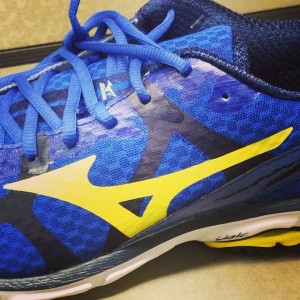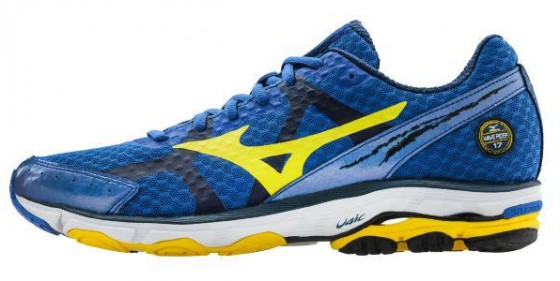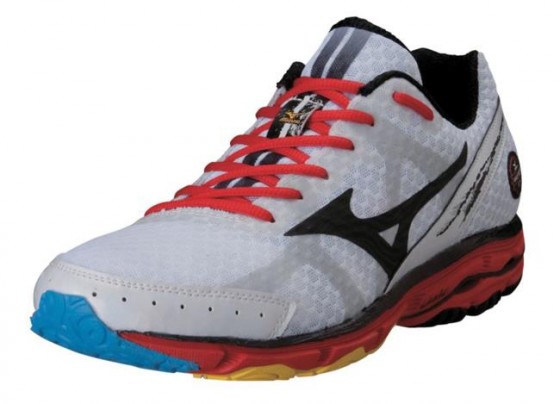 I have a shoe rotation that includes minimalist, performance, racing flats, and running shoes. Of these, I put the bulk of my mileage on running shoes – I use them on all of those long, slow, boring runs that nobody really cares to hear about. I typically put in around 50 miles a week, with only about 15-20 of those being quality. This leaves about 30 miles per week for me to log on cushioned running shoes. That means I get an average of about 2 months out of a pair of running shoes, so I’m always in the look out for a new favorite to keep me company on those runs when I’m half asleep and daydreaming about breakfast. That’s how I stumbled upon this new Mizuno Wave Rider 17 (these cost around 5,000php but you can get these for only 999 if you are luck enough to win Mizuno Run Club's #If EverybodyRanPromo - see details below).
I have a shoe rotation that includes minimalist, performance, racing flats, and running shoes. Of these, I put the bulk of my mileage on running shoes – I use them on all of those long, slow, boring runs that nobody really cares to hear about. I typically put in around 50 miles a week, with only about 15-20 of those being quality. This leaves about 30 miles per week for me to log on cushioned running shoes. That means I get an average of about 2 months out of a pair of running shoes, so I’m always in the look out for a new favorite to keep me company on those runs when I’m half asleep and daydreaming about breakfast. That’s how I stumbled upon this new Mizuno Wave Rider 17 (these cost around 5,000php but you can get these for only 999 if you are luck enough to win Mizuno Run Club's #If EverybodyRanPromo - see details below).I have had a pair of the Mizuno Wave Rider 16s for quite some time now, but only used it a couple of times as I rely more on my other running shoes which I found more interesting. I have nothing against the 16s as they are good running shoes though it seemed heavy and underwhelming, that's why I am excited about trying these new 17s. What I did not realize was how dramatic of a change Mizuno had made in this update. Let’s compare the two models on a few key metrics:
Mizuno Wave Rider 16
Features
- An industry legend just got even better
- Well cushioned with the new Smooth Touch Cushioning
Specifications
- Weight: 280g
- Colors: Blazing Yellow/Imperial Blue/Anthracite, White/Chinese Red/Anthracite
- Sizes: 7-12
- Style: 08KN30227
Technology
Mizuno Wave Rider 17
Features
- U4ic midsole delivers lightweight, resilient cushioning.
- Dissolving upper fit with new DMF execution and soft, supple mesh materials.
- SmoothRide Engineering for a brilliant run.
- Lateral Forefoot Sculpting for smooth touchdown and transition.
- Blown rubber forefront with deep flex grooves for optimal flexibility and cushioning.
Specifications
- Weight: 250g
- Colors: White/Black/Fiesta, Blue/Yellow/Blue, Lime/Black/Red
- Sizes: 6-11, 12
- Style: J1GC140309
Technology
Yup, you’re reading that correctly, Mizuno dropped the weight considerably in the Wave Rider 17. Out of the box, I easily noticed the 1.4 ounces of weight that Mizuno managed to shave off of these running shoes. This was apparently made possible by Mizuno’s new U4ic midsole material (cool eh?), which Mizuno claims is lighter and just as cushioned as their previous midsole compounds.
Based on the Wave Rider 17 shoe's features and specifications, its new midsole seems to add a slightly steeper offset, and makes it somewhat a taller shoe all around, so don’t expect to feel more ground contact. Although the heel-to-toe drop is one of the largest of all my running shoes, I still didn't feel that it caused me to break form throughout my easy runs. More than likely (I have not had my stride analyzed), I have a slight heel strike when I’m running slow and easy, so it’s useful to have a heavier duty rubber outsole on the heel. Like most running shoes, these do not have much torsional flexibility in the midfoot (It's hard or you won't be able to twist them by hand).
One concern I had with the Wave Rider 17 was how stiff the forefoot felt with its rubber outsole. This left the balls of my feet feeling beat up after the first couple of runs. Thankfully, I stuck it out and found that the more I wore the shoes, the more flexible the forefoot became. I asked a Mizuno representative about this, and they agreed that there seems to be a “sweet spot” of about 50 miles when the shoes break-in. The Wave Rider 17s now give my toes the ability to bend backwards as they like. I’m happy to tell you guys that I have had no pain in my feet in over a week while running in these shoes almost exclusively.
The upper of the Mizuno Wave Rider 17 is a soft mesh construction that is very breathable and very comfortable. I felt that there was plenty of room in the forefoot for my toes to move freely.
Pros:
Much lighter than most traditional trainers
Very soft, breathable mesh upper
Cons:
Large heel-to-toe offset could cause issues for those sensitive to a high-drop shoe
More shoe than some runners prefer
Long break-in period to achieve desired flexibility (took ~70 miles until they started becoming comfortable for me)
Conclusion:
Overall, I’m very happy with my Mizuno Wave Rider 17. I believe that Mizuno did a great job in maintaining the aspects that people have come to love about their running shoes (cushioning, solid construction, comfortable fit), while making a tremendous update with the new midsole. For sure, running shoe enthusiasts describe the perfect running shoe as one that disappears on your foot while running. While the Mizuno Wave Rider 17 is still a traditional, cushioned trainer, it is a certainly a good step toward this. These are now on my short list for favorite running shoes. And #IfEverybodyRan wearing these Wave Riders, then all of us will be healthy, happier, smarter, and of course will be a better person. #NeverSettle Guys!














Post a Comment